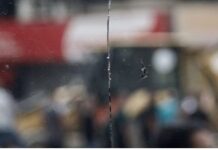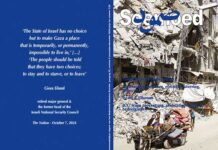Nargol Aran
Mondoweiss / November 22, 2024
On the martyrdom of Ismail Haniyeh as Iran inaugurated a new president, and the ways the Martyr may enable us to see a path forward to break a siege that stretches from Tehran to Gaza.
It is voting day in Tehran, the second round of the Iranian presidential election, Friday, July 5th, 2024. The aroma of fried herbs and saffron rice wafts from open windows. My extended family and I walk to the mosque. Three teenage boys are deep in an aluminium garbage bin scavenging for recyclables — frontline of an American-imposed siege pushing a third of Iranians below the poverty line. I hand them popsicles and cake I bought from the corner grocery store. They eagerly rip open the shiny plastic wrap and devour what’s inside. They are hungry. This force, hunger, is weakening entire populations across our region. In Gaza, 2000 km from here, people are grinding animal feed and boiling leaves to stay alive in a genocide being broadcast live. For the longest time I wondered if we could see a way through this suffocating fortress that gnaws in the stomach of our youngest and most vulnerable. On this day our resistance may be opening a path to ourselves.
The events of the past years spin in my head like a zoetrope: crying in pain of burning my arm taking bread out of the oven as I heard the news of the assassination of Iran’s most senior military commander | people scrambling in desperation as they buried loved ones in a pandemic under a suffocating siege | standing all alone to cast my ballot in an election where almost all meaningful competition was disqualified | trembling in fear while walking home on a burning sidewalk, the smell of fuming garbage invading my flesh, as our streets erupted in despair | the feeling that we were sinking and could not save ourselves. The region was heading in only one direction, normalization with Israel, and the erasure of all, like us, that had been an obstacle.
And then, on October 7, 2023, the skies of Gaza birthed the possibility of another redemption. On that day, the Palestinian Resistance broke the world’s most repressive siege. In Al-Aqsa Flood, Palestinians tore down the gates of their own prison, embodying what I understood Walter Benjamin to mean by jetztzeit, translated as now-time, a revolutionary moment in which the oppressed can disrupt the flow of history to create transformative change. He writes “the past carries with it a secret index by which it is referred to redemption” suggesting that reimagining the inevitable unlocks a pathway to liberation.
But those who dare defy the greatest darknesses are those closest to its wanton lust for blood. Gaza hadn’t just bruised a colonial outpost but its patrons, the Western-imposed order, and they would come for revenge — more savage, and open than any humanity has ever witnessed. There would be no limit to the horrors Israel would be enabled to inflict before our eyes. Gaza, Palestine, the homeland of Isa ibn Maryam, would be crucified.
70,000 tonnes of explosives have been dropped on Gaza, more than what decimated London, Hamburg, and Dresden combined in World War II. On the ground, even thoughts of the terror defy perception: 300 bullets into the body of a 6-year-old girl trembling among her dead relatives, already killed by Israel, waiting for emergency medics who were also killed. The razing of entire hospitals over and over and the murder of patients and doctors in mass graves. German and U.S. politicians not only provide the weapons, but vocally support Israel’s targeting of Palestinians. Western regimes confess that the “rules-based order” was always their singular right to massacre without repercussions.
The depravity is now open but it is not new. The world is just starting to see what our elders saw and risked their lives to upend. Revolutionary Iran positioned itself with the indigenous struggle in our region against the U.S. hegemon. It called America the Great Satan, and Israel Little Satan, the “germ of corruption on earth that the imperialists have planted in the heart of the Muslim world.” It transformed into a formidable link to what would be called the Resistance Axis, a network of state and non-state actors vested in Palestinian self-determination for recognizing the Israeli occupation as an imperial aggression on their own sovereignty. Today, the Resistance is the singular force standing against this unprecedented barbarity. As its most powerful nation-state backer, Iran is the only country to throw its weight, both militarily, putting itself on the direct line of Israel’s fire, and politically, to stop genocide. It would thus sustain the same wrath while it dared stand as a beacon of honour in this complicit, silent world.
When Israeli and American officials speak openly about breaking Iranian will through sanctions, isolation and terrorism, a country of 1.65 million square kilometers that they can’t invade or bomb their way out of, they specifically allude to Iran’s disintegration into smaller penetrable states. In such conditions which Iran has found itself continuously in my lifetime, the election has served as a singular point of national solidarity. Every four years I walk to the same mosque we are headed towards today, to vote with thousands of others, in a shared vision, despite our differences, that no matter what we wanted to change from within, we would do so on our own terms. We came together in a oneness declared through the ballot box, an affirmation of our commitment to the nation-state.
But that united front had fractured deeply in the years following Maximum Pressure, the most destabilizing iteration of the siege, announced by the Trump Administration in 2018. Henceforth, the elections were compromised internally, disqualifying factions that had long been considered pillars of the post-revolutionary state project. Our Nizam, entire political establishment headed by the Supreme Leader, appeared aloof to the dangers that loomed before us, closing in on itself, purging faithful allies and longtime servants. Many sat home in protest. Bloody riots erupted within a year. The attempt to divide us had worked and we had to reverse it, though I didn’t quite know how.
Snap elections were called in May 2024 when Iran’s president and foreign minister were killed in a shock helicopter crash. Our country could not afford to be so fractured at the critical months after Al-Aqsa Flood when we were being targeted with assassinations, bombings, and new sanctions. It was vital for the Nizam to oversee a U-turn and allow for greater participation in a show of strength and solidarity. Signs indicated that it did. Acknowledging the significance of the election, it tried to walk back what it had sacrificed to domestic political rivalries. It opened space for substantial competition. But our rupture had already bruised us. A call was made that might remain unanswered. The election turnout had been the lowest of my lifetime though it was close enough to go to a second round.
I held the anger and exhaustion of the nation and the dangers that threatened its integrity at once. People would vote for different reasons, but anyone who did recognized that the election as an effort to address the urgency of Iran’s predicaments. I thought to myself that if less than 49% of voting-age Iranians participated in the second round, our effort could be deemed a failure. If not even half of the Whole I am trying to maintain in our shared vision agree with this, it can’t be real.
I always look up to see the blue dome first at the turn. We are near the mosque, a standing monument to Iran’s Revolution. In this historic place, more than 50 years ago, teachers preached revolt to the hearts of young people, directly naming Israel as the perpetuator of an unacceptable order that dishonoured our societies from Iran to Palestine. Together they led a Revolution that ends here where we are. And it was now our turn to carry what remained of their defiance, ourselves, to safety.
The lines are not as long as when they twirled for kilometers in those previous times I’ve voted, but extend enough. A moustached man in his 60s stands in front of my uncle, his arms folded calmly surveying the line. He tells us that he is “voting in secret” from his children who live abroad and who’ve demanded he stay away. “They think I’m at home listening to the drivel on Iran International.” And then he says quietly “but we know the nation had to show itself.”
It is our turn inside. We are beneath the dome now, sunlight shining on us through the golden drum. A family is being interviewed by a Chinese TV station behind me. Administrators of the interior ministry hand us the ballots. There is flow and ease in their smiles. I write a name and a number and put my paper into a vessel— a blue bin—from which would emerge a Name that was ours. Exit polls are announced at 49.8%. The call to unity had been honoured but not without revealing its fragility.
I get up a few weeks later on the morning of July 31, earlier than usual. The sounds of sparks from the stove pilot light, a miniature machine gun, awaken me. Momma has brewed the tea and is by the countertop cutting cucumbers, her long salt and pepper hair dishevelled to her waist. I can’t make out her eyes but I can tell she is looking blankly into space. The knife in her hand moves like a swish of a machine. The light brown MVF of the countertop assumes the consistency of sand getting into my eyes and nose, inhibiting inhalation. Death is everywhere though I do not know whose.
“What’s wrong momma?” I screech.
Nothing. She doesn’t hear me.
“Momma, what is it?” This time louder.
She finally looks at me. There are tears in her eyes. “Ismail Haniyeh” is all she says. And the next moment I see us crash to the ground, covering our eyes with our arms, weeping. Israel has assassinated Iranian scientists in front of their children on our streets, the U.S. has killed our most respected military leader in an airport, but murdering a foreign dignitary who was our official diplomatic guest was not what we were prepared for. Gaza isn’t even safe here, with us, because we too are a battleground.
Yesterday was the presidential inauguration. It was a day of relief. The president is a heart surgeon who has both revolutionary credentials as a veteran of the Imposed War and has spoken about the urgent need for domestic political reforms. He seems like a sensible person for the moment. The Nizam signals it is ready to enact changes on the highly contentious mandatory hijab law and internet censorship, and also revitalize the economy, which is undoubtedly tied to our relationship to the world, that place controlled by the force (the U.S.) with whom we are simultaneously at war. Inside Iran’s parliament, the Parliament Speaker and President read their speeches in front of dozens of world dignitaries. On this day, it appears that Iran can remain defiant and find a way out of its quandaries at once. I am proud to see leaders of the Resistance Axis, among them Ansarallah, Hizbullah, and Hamas, represented by their chief negotiator Ismail Haniyeh, sit in the front row.
Back in April, three of Haniyeh’s sons and four of his grandchildren were killed by an Israeli airstrike on their car in Gaza that left the vehicle and bodies charred beyond recognition. He had been visiting a hospital where Palestinian evacuees were in Doha, and when they told him, he looked down, said a prayer, and continued the visit. His faith in that moment, in all of Gaza being subject to terror not excluding his own, has remained with me. Now they had killed him while he was our guest.
I was aware, as our numbers in the election had shown, that our every action leading to ease, would be conditional and precarious. Under assault by our enemies, our commitment to our continuation would cyclically need to be reaffirmed. Just months before, days after Tehran hosted Martyr Ismail Haniyeh, Israel bombed the Iranian consulate in Syria, assassinating our military attaché including one of our most senior Quds Force commanders who served as a key link to Hizbullah — the only army confronting the Israeli Occupation Forces directly. As I had watched the Resistance leaders in Tehran again yesterday, it wasn’t lost on me that this was just a short reprieve. An unease lingered about what would follow. But I had no way of knowing that our martyr this time would be a Palestinian from Gaza.
On this early Friday morning of August 1, 2024, my family and I are walking to Namaz-e Mayyit, Prayer of the Dead, for Ismail Haniyeh at the University of Tehran. Like a wave shoaling, every minute the crowd gets bigger as mourners roll into the streets. The yellows and greens of the Resistance flags add pops of colour to the sombre colours of our mourning attire. Families are sitting upon mats on the sidewalks. A lament honouring the martyr is performed over the speaker. I wish I could sit and weep, like some of the women around me. I’ve felt the need for months, but we have yet to find our place. Running children whisk past me brushing my chador. They stop ahead at a man in a keffiyeh handing out little packets of sweets.
What I had thought would be a moment of relief (the inauguration) had turned into catastrophe (martyrdom). But the Resistance could not exist, given the stark power imbalance, if the tragedy our enemies inflict couldn’t be woven into perseverance. That is in essence what we Shi’a believe the martyr to be: not a final death but a path through which the living can seek continuation.
Ayatollah Ali Khamenei, Iran’s Supreme Leader, will be leading the prayer. Politically, he holds the country’s highest office, but as the leader of the Revolution he is also our spiritual connection to the Resistance. He has remarked in the past that for the Revolution to remain viable its leaders must fearlessly call us to ourselves, even at the risk of personal safety.
In 1981, at Tehran’s Abuzar Mosque, a booby-trapped tape recorder went off permanently paralyzing his right arm. As president, he led the Friday Prayer in 1985 in this very same location where a bomb exploded as he gave his sermon. Iraq, at war with Iran on behalf of the U.S., had threatened to target the prayers, but people showed up regardless. They shouted “Death to America” relentlessly right after the explosion, and within minutes Khamenei continued his speech, “We resist on the battlefield and they hit our hospitals and Friday prayers” — as if speaking of Gaza today where people are massacred at hospitals and jemaa’at (congregational) prayers.
Near the university entrance, the crowds get bigger as people wait to go inside. We decide to stay put in case we don’t make it in on time. It is the right decision since the prayer begins shortly. The Leader’s voice, fiery preacher of revolution now burnished by old age, calls to the people:
Ashhadu alla ilaha illa Allah vahdahou la sharika lah
I bear witness that there is no god but Allah who has no partner
We stand in formation behind him, one after another in rows, like drops of mercury coalescing, strangers gathered on a weekend morning for these mere minutes to call to the oneness of the creator, and the righteousness of our Resistance. There is a siege on this city that extends to the genocide on Gaza, but here our Palestinian martyr is the shining star of existence turning this slab of concrete into sacred ground. The crows bark, the birds chirp, and a unison of human voices pray in his honour. I have stood under the resplendent dome of Shah Mosque in Isfahan, and I realize then and there that it is this kind of warmth that those golden tiles dispersed among the blue are trying to mimic. Our ritual ends as soon as it begins, a journey of the soul that defies time, as we hear the final “Allah o Akbar”. And I look up at the people beside me. Tears are running down our faces. Our Oneness would be targeted and reified.
Nargol Aran writes from Tehran, Iran












